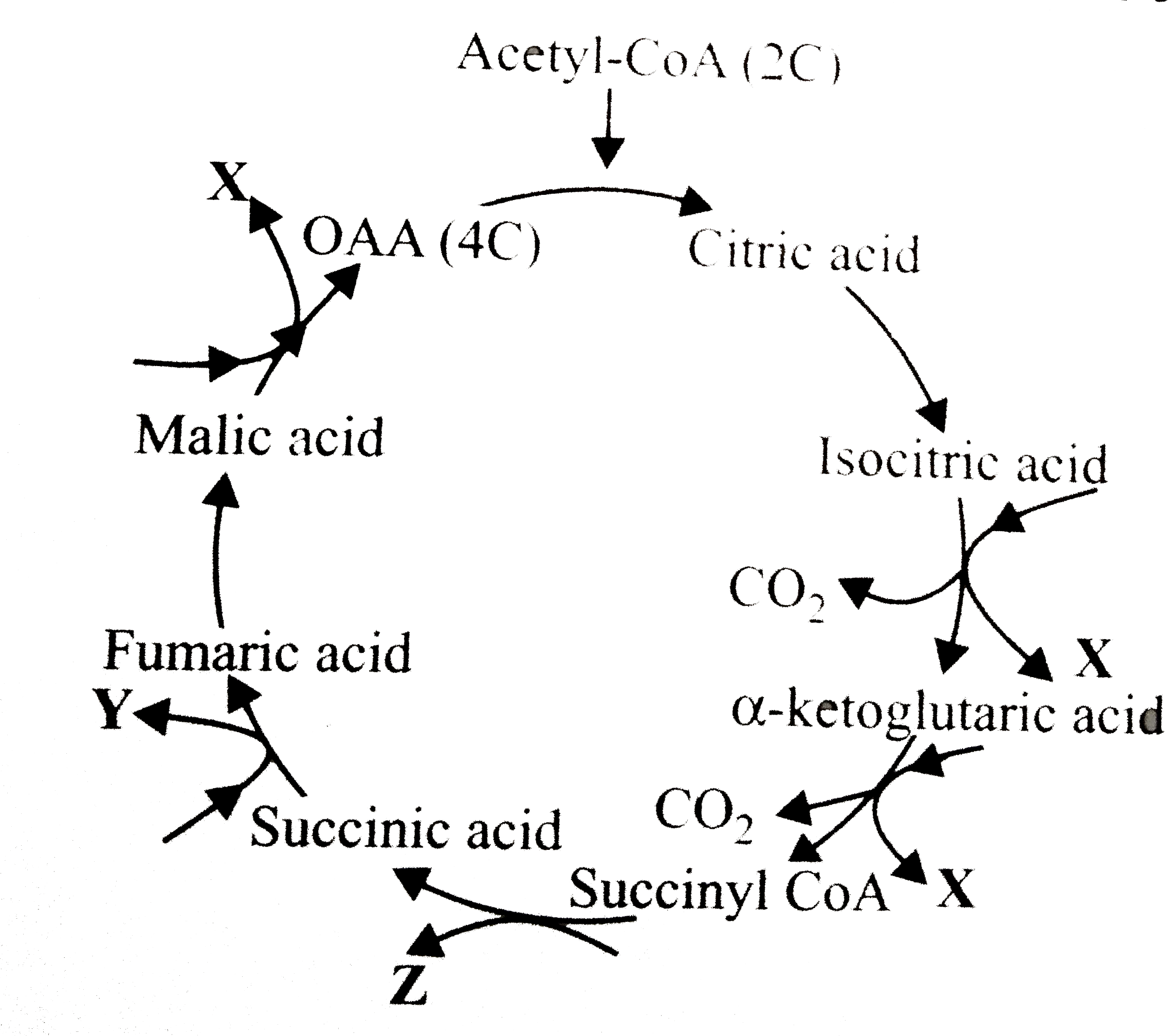Give the graphic representation of citric acid cycle.
Step-by-Step Solution for the Graphic Representation of the Citric Acid Cycle
1. Introduction to the Cycle:
- The Citric Acid Cycle, also known as the Tricarboxylic Acid (TCA) Cycle or Krebs Cycle, is a crucial part of cellular respiration that occurs in the mitochondrial matrix.
2. Starting Point:
- The cycle begins with the condensation of an acetyl group (from Acetyl-CoA) and oxaloacetate to form citric acid (citrate).
- Enzyme: Citrate synthase.
3. Formation of Isocitrate:
- Citric acid is then converted into isocitrate.
- Enzyme: Isocitrate dehydrogenase.
4. First Decarboxylation:
- Isocitrate undergoes oxidative decarboxylation to release carbon dioxide and form alpha-ketoglutarate.
- Enzyme: Isocitrate dehydrogenase.
5. Second Decarboxylation:
- Alpha-ketoglutarate is further converted into succinyl-CoA through another oxidative decarboxylation, releasing another molecule of carbon dioxide.
- Enzyme: Alpha-ketoglutarate dehydrogenase.
6. Substrate-Level Phosphorylation:
- Succinyl-CoA is converted into succinate, which involves substrate-level phosphorylation and the release of energy.
- Enzyme: Succinyl-CoA synthetase.
7. Conversion to Fumarate:
- Succinate is then oxidized to fumarate.
- Enzyme: Succinate dehydrogenase.
8. Formation of Malate:
- Fumarate is converted into malate.
- Enzyme: Fumarase.
9. Regeneration of Oxaloacetate:
- Finally, malate is oxidized back to oxaloacetate, completing the cycle.
- Enzyme: Malate dehydrogenase.
10. Cycle Completion:
- The cycle is now ready to begin again with another acetyl group, as oxaloacetate is regenerated.
Graphic Representation
To create a graphic representation of the Citric Acid Cycle, you can draw a circular diagram with the following components:
- Start: Acetyl-CoA + Oxaloacetate → Citrate
- Steps:
- Citrate → Isocitrate
- Isocitrate → Alpha-Ketoglutarate + CO₂
- Alpha-Ketoglutarate → Succinyl-CoA + CO₂
- Succinyl-CoA → Succinate + Energy
- Succinate → Fumarate
- Fumarate → Malate
- Malate → Oxaloacetate
- Enzymes: Label each step with the corresponding enzyme.
- The Citric Acid Cycle, also known as the Tricarboxylic Acid (TCA) Cycle or Krebs Cycle, is a crucial part of cellular respiration that occurs in the mitochondrial matrix.
- The cycle begins with the condensation of an acetyl group (from Acetyl-CoA) and oxaloacetate to form citric acid (citrate).
- Enzyme: Citrate synthase.
- Citric acid is then converted into isocitrate.
- Enzyme: Isocitrate dehydrogenase.
- Isocitrate undergoes oxidative decarboxylation to release carbon dioxide and form alpha-ketoglutarate.
- Enzyme: Isocitrate dehydrogenase.
- Alpha-ketoglutarate is further converted into succinyl-CoA through another oxidative decarboxylation, releasing another molecule of carbon dioxide.
- Enzyme: Alpha-ketoglutarate dehydrogenase.
- Succinyl-CoA is converted into succinate, which involves substrate-level phosphorylation and the release of energy.
- Enzyme: Succinyl-CoA synthetase.
- Succinate is then oxidized to fumarate.
- Enzyme: Succinate dehydrogenase.
- Fumarate is converted into malate.
- Enzyme: Fumarase.
- Finally, malate is oxidized back to oxaloacetate, completing the cycle.
- Enzyme: Malate dehydrogenase.
- The cycle is now ready to begin again with another acetyl group, as oxaloacetate is regenerated.
To create a graphic representation of the Citric Acid Cycle, you can draw a circular diagram with the following components:
- Steps:
- Citrate → Isocitrate
- Isocitrate → Alpha-Ketoglutarate + CO₂
- Alpha-Ketoglutarate → Succinyl-CoA + CO₂
- Succinyl-CoA → Succinate + Energy
- Succinate → Fumarate
- Fumarate → Malate
- Malate → Oxaloacetate
Topper's Solved these Questions
- RESPIRATION IN PLANTS BOOK - MODERN PUBLICATIONCHAPTER - RESPIRATION IN PLANTS EXERCISE - REVISION EXERCISES (Long Answer Questions)
5 Videos
- RESPIRATION IN PLANTS BOOK - MODERN PUBLICATIONCHAPTER - RESPIRATION IN PLANTS EXERCISE - COMPETITON FILE OBJECTIVE TYPE QUESTIONS (A. MULTIPLE CHOICE QUESTIONS)
30 Videos
- RESPIRATION IN PLANTS BOOK - MODERN PUBLICATIONCHAPTER - RESPIRATION IN PLANTS EXERCISE - REVISION EXERCISES (Very Short Answer Questions)
16 Videos
- PLANT KINGDOM BOOK - MODERN PUBLICATIONCHAPTER - PLANT KINGDOM EXERCISE - Chapter Practice Test
16 Videos
- STRUCTURAL ORGANISATION IN ANIMALSBOOK - MODERN PUBLICATIONCHAPTER - STRUCTURAL ORGANISATION IN ANIMALSEXERCISE - CHAPTER PRACTICE TEST (Section -E)
2 Videos
Similar Questions
Knowledge Check
The citric acid cycle
AIs the major anabolic pathway for glucose synthesisBIs an anaerobic processCGenerates fewer molecules of ATP than glycolysisDContains intermediates for amino acid synthesisCitric acid is
Amonocarboxylic acidBdicarboxylic acidCtricarboxylic acidDfatty acidIdentify X,Y and Z in the given diagram representing steps of citric acid cycle and select the correct option.
 AXYZGTPNADH2FADH2BXYZFADH2NADH2GTPCXYZNADH2FADH2GTPDXYZCO2NADH2ADP
AXYZGTPNADH2FADH2BXYZFADH2NADH2GTPCXYZNADH2FADH2GTPDXYZCO2NADH2ADP
